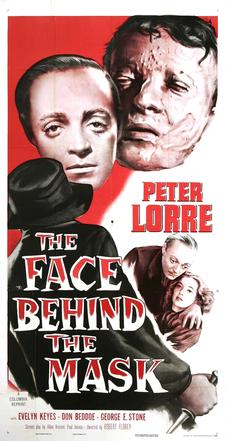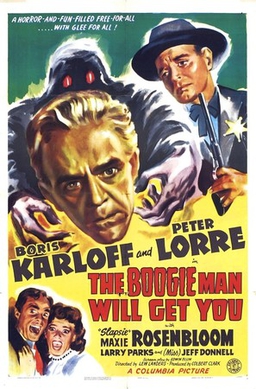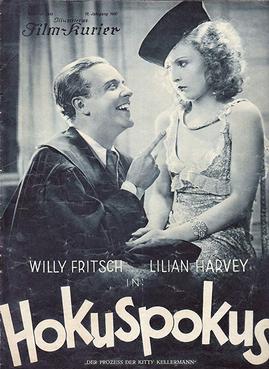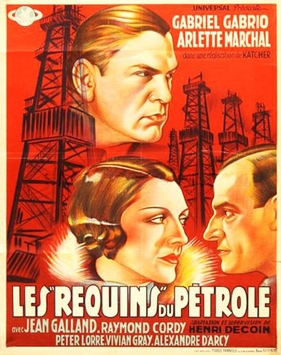
Peter Lorre was a Hungarian and American actor, active first in Europe and later in the United States. He began his stage career in Vienna, in the Austro-Hungarian Empire, before moving to Germany, where he worked first on the stage, then in film, in Berlin during the late 1920s and early 1930s. Lorre caused an international sensation in the Weimar Republic–era film M (1931). Directed by Fritz Lang, Lorre portrayed a serial killer who preys on little girls.

The Face Behind the Mask is a 1941 American crime horror film directed by Robert Florey and starring Peter Lorre, Evelyn Keyes and Don Beddoe. The screenplay was adapted by Paul Jarrico, Arthur Levinson, and Allen Vincent from the play Interim, written by Thomas Edward O'Connell (1915–1961).

Oskar Homolka was an Austrian film and theatre actor, who went on to work in Germany, Britain, and America. Both his voice and his appearance fitted him for roles as communist spies or Soviet officials, for which he was in regular demand. By the age of 30, he had appeared in more than 400 plays; his film career covered at least 100 films and TV shows.

The Boogie Man Will Get You is a 1942 American comedy horror film directed by Lew Landers and starring Boris Karloff and Peter Lorre. It was the final film Karloff made under his contract with Columbia Pictures, and it was filmed in the wake of his success in the 1941 Broadway production Arsenic and Old Lace. As he had done several times previously, Karloff played the part of a "mad scientist", Professor Billings, who is using the basement of his inn to conduct experiments using electricity to create a race of superhumans. The inn is bought by a new owner, who is initially unaware of the work Billings is conducting.

The Lost One is a 1951 West German crime drama film directed by Peter Lorre and starring Lorre, Karl John and Renate Mannhardt. It is an art film in the film noir style, based on a true story. Lorre wrote, directed, and starred in this film, his only film as director or writer. The film's translated name has been used as the title of his biography.

Hocuspocus is a 1930 German comedy film parallel version directed by Gustav Ucicky, starring Anglo-German Lilian Harvey, Willy Fritsch, and Oskar Homolka. It was the first adaptation of the 1926 play Hokuspokus by Curt Goetz, but used different role names.
![<i>Invisible Adversaries</i> 1977 [[Cinema of Austria|Austria]] film](https://upload.wikimedia.org/wikipedia/en/5/5f/InvisibleAdversariesDVDcover.jpg)
Invisible Adversaries is a 1977 Austrian experimental drama film directed by Valie Export, her debut feature film.

The White Demon is a 1932 German drama film directed by Kurt Gerron and starring Hans Albers, Gerda Maurus and Peter Lorre. The film is also known by the alternative title of Dope. The sets were designed by the art director Julius von Borsody.

What Women Dream is a 1933 German comedy crime film directed by Géza von Bolváry and starring Nora Gregor, Gustav Fröhlich, and Otto Wallburg. In 1934, it was remade as an American film One Exciting Adventure. The film's sets were designed by the art directors Emil Hasler and Willy Schiller.
The Missing Wife is a 1929 Austrian silent film comedy crime film directed by Karl Leiter and starring Harry Halm, Iris Arlan and Mary Kid. The sets were designed by the art director Hans Ledersteger.

The Oil Sharks is a 1933 German drama film directed by Rudolph Cartier and Henri Decoin and starring Arlette Marchal, Vivian Grey and Gabriel Gabrio. It is the French-language version of Invisible Opponent, made with the same crew but a largely different cast and some alterations to the story line. The sets for both films were designed by the art director Erwin Scharf.
Rudolf Schaad was a Russian-born German film editor. He edited the 1933 film Invisible Opponent and its French-language version The Oil Sharks.
Josef Dahmen was a German stage, film and television actor.

Third from the Right is a 1950 West German musical crime film directed by Géza von Cziffra and starring Vera Molnar, Robert Lindner and Peter van Eyck. It was made by the Hamburg-based company Real Film at the Wandsbek Studios in the city. The film's sets were designed by the art director Herbert Kirchhoff.

The Little Town Will Go to Sleep is a 1954 West German comedy film directed by Hans H. König and starring Gustav Fröhlich, Jester Naefe and Helen Vita. It shares its title with a popular song of the era. It was shot at the Wiesbaden Studios in Hesse and partly on location at Limburg an der Lahn. The film's sets were designed by the art director Hans Sohnle.

The Stranger is a 1931 French-German drama film directed by Fred Sauer and starring Gerda Maurus, Peter Voß and Harry Hardt.
Alarm at Midnight or Help! Armed Assault! is a 1931 German thriller film directed by Johannes Meyer and starring Hans Stüwe, Hans Brausewetter, and Otto Wallburg.

In the Name of the People is a 1939 German crime film directed by Erich Engels and starring Rudolf Fernau, Fritz Kampers, and Rolf Weih. The film's sets were designed by the art directors Hans Sohnle and Wilhelm Vorwerg. It was shot at the Babelsberg Studios in Berlin.







![<i>Invisible Adversaries</i> 1977 [[Cinema of Austria|Austria]] film](https://upload.wikimedia.org/wikipedia/en/5/5f/InvisibleAdversariesDVDcover.jpg)






